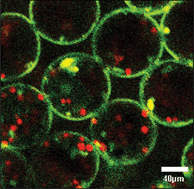Cellular scaffolds made on the basis of inverted colloidal crystals (ICC) provide a unique system for investigation of cell–cell interactions and their mathematical description due to highly controllable and ordered 3D geometry. Here, we describe three new steps in the development of ICC cell scaffolds. First, it was demonstrated that layer-by-layer (LBL) assembly with clay/PDDA multilayers can be used to modify the surface of ICC scaffolds and to enhance cell adhesion. Second, a complex cellular system made from adherent and non-adherent cells co-existing was created. Third, the movement of non-adherent cells inside the scaffold was simulated. It was found that floating cells are partially entrapped in spherical chambers and spend most of their time in the close vicinity of the matrix and cells adhering to the walls of the ICC. Using this approach one can efficiently simulate differentiation niches for different components of hematopoietic systems, such as T-, B- and stem cells.
You have access to this article
 Please wait while we load your content...
Something went wrong. Try again?
Please wait while we load your content...
Something went wrong. Try again?


 Please wait while we load your content...
Please wait while we load your content...